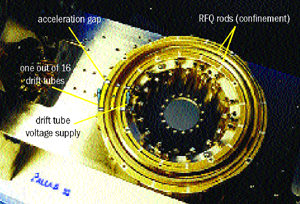
A model set up at Munich’s Ludwig-Maximilians University has for the first time achieved a high level of “crystallization” of particle beams in a ring.
The particles orbiting in conventional circular accelerators are controlled by carefully arranged electric and magnetic fields. One long-sought-after aim is to freeze out the relative motion of the particles in the ring so that the accelerator fields hold them firmly in place, similar to atoms in a crystal lattice, giving beams of unprecedented brilliance.
The first signs of such behaviour were seen some 20 years ago at Novosibirsk using the then new electron cooling approach, which was pioneered at Novosibirsk. The behaviour has since been reproduced – notably at the ESR storage ring at Darmstadt’s GSI laboratory. The extremely precise momentum definition needed to achieve such conditions makes for very accurate mass spectrometry.
However, the beam ordering seen under these conditions is far from complete and can be understood as particles losing their ability to overtake each other. Three-dimensional arrangements of ions have been achieved in particle traps using additional techniques, such as laser cooling to damp the residual motion of particles.
Physicists at Ludwig-Maximilians University built a special table-top storage ring that uses the radiofrequency quadrupole (RFQ) technique normally used in linear accelerators. Their 12 cm diameter PALLAS ring can be likened to a ring-shaped quadrupole ion guide. The radial confinement of the ions, as well as the bending, is provided by the RFQ ring electrodes. The ring is additionally equipped with drift tubes uniformly distributed around the circumference. These generate static electric fields, which can be used to transport and position ions longitudinally and to bunch the beam.
The ion beam attained a velocity of 2800 m/s – equivalent to a beam energy of 1 eV. The number of ions involved, some 105, is small by the standards of particle accelerators and storage rings, but the ideas could be scalable to larger machines.
Further reading
T Schätz, U Schramm and D Habs 2001 Nature 412 717.





